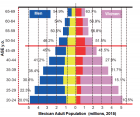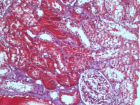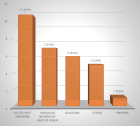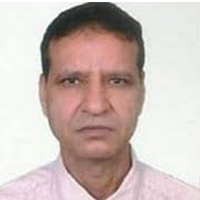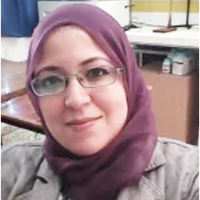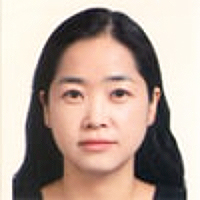About Federal University of Technology
Federal University of Technology
Articles by Federal University of Technology
Evaluation of the effects of Leech Salivary Extract (LSE) on Haematological parameters in Rats
Published on: 19th January, 2018
OCLC Number/Unique Identifier: 7355940230
The effects of Leech Salivary Extract (LSE) on some haematological, immunological and organ weight parameters in rats, during a twenty eight days oral administration of 25, 50 and 100 mg/kg body weight doses, was investigated. LD50 and sub chronic toxicity was determined using standard methods. The oral LD50 was above 5000mg/kgbw. Oral administration of LSE (25mg/kgbw, 50mg/kgbw, 100mg/kgbw) for 28days had no significant (p>0.05) effect on the differential white blood cells (lymphocytes, monocytes, basophils, neutrophils, eosinophils), red blood cell indices (RBC count, PCV, HB, platelets, MCHC and MCH), feed intake, body weight gain and relative organ weight of lung, heart, liver, kidney, spleen and stomach of rats. However, the LSE evoked a significant (p>0.05) increase in the level of MCV in treated rats compared to the control. These results, indicating low toxicity and no negative significant effects of LSE on haemato-immunological indices in rats, suggest that the extract is safe for development and use as therapeutic for managing clinical conditions.
Risk evaluation and modeling of soils contaminated with Polycyclic Aromatic Hydrocarbons (PAHs) in parts of Bonny Island, Niger Delta, Nigeria
Published on: 27th May, 2020
OCLC Number/Unique Identifier: 8609740211
Environmental impact of a recent oil spill incident in Bonny terminal using soil media was studied using a risk-based modeling approach. The establishment of the presence of contaminants of concern (CoC), evaluation/assessment, modeling spilled volume and ascertaining potential health risk associated with the spill incident was carried out. The Contaminant of Concern (CoC) included Total Petroleum Hydrocarbons (TPH) and Polycyclic Aromatic Hydrocarbons (PAHs). Soils and groundwater were sampled in the vicinity of the spill incident and further away into the surrounding communities. Soils were sampled into the depths (0.1 m, 0.5 m,1.0 m, 1.5 m), and the results of sieve analysis revealed that the area is predominantly silty sand in composition. This study also revealed that TPH concentration at all locations and depths exceeded DPR target value of 50 mg/kg. The TPH model revealed that a total volume of 222,500m3 of the spill area exceeded DPR intervention value of 5000 mg/kg. The results of PAH showed that only BS-1, BS-6, BS-8, BS-9 and BS-10 exceeded DPR target value of 1.0 mg/kg at some depths. All other sample depths and locations were within the target limit. The 3-D grid generated for PAH showed that 563,000m3 of the study area exceeded the DPR target value. The 3-D block models generated for TPH and PAH, along with the cross-sections and extracted time slices all showed that the concentration of the Contaminant of Concern (CoC) generally decreased with depth, and the centre of the spill located at the south-eastern part of the survey area. Based on these models, three spill zones were identified; Zone 1-highly contaminated areas (BS-8, BS-9, BS-10); Zone 2 - moderately contaminated areas (BS-1, BS-2, BS-6, BS-7); and low contaminated areas (BS-3, BS-4, BS-5). The entire soil in the area were contaminated with TPH and 47% of the area contaminated with PAH. This study has shown the effectiveness of the use of a model-based approach in quantifying hydrocarbon contamination volumes in the area. There is therefore the need for continuous monitoring of hydrocarbon spills in the area.
Measurement of background ionizing radiation in the federal university of technology owerri, Nigeria using calibrated digital geiger counter
Published on: 25th May, 2020
OCLC Number/Unique Identifier: 8621042354
The measurement of the natural ionizing radiation in the Federal University of Technology Owerri, Nigeria was carried out using a well calibrated Digital Geiger Muller counter models GCA – 04w. Measurements were taken randomly in thirty (30) diff erent locations outside the building and thirty (30) locations inside diff erent buildings in the University. Results obtained for outdoor Dose rate ranges from 0.07 μSv/hr to 0.23 μSv/hr with a mean value of 0.144 μSv/hr. While the result for the indoor dose rate ranges from 0.08 μSv/hr to 0.21 μSv/hr with a mean of 0.14 μSv/hr. The highest value recorded for the outdoor radiation is from the university front gate which is .023μSv/hr. While the highest value recorded inside the buildings is from the School of Agriculture and Agricultural Technology (SAAT) which is 0.21 μSv/hr. All these values are lower than the world safely limits of 0.247 μSv/hr. This shows that the risk of ionizing radiation on the staff and students of the Federal University of Technology is minimal.
Radionuclide contents in yam samples and health risks assessment in Oguta oil producing locality Imo State Nigeria
Published on: 5th April, 2021
OCLC Number/Unique Identifier: 9024345201
Oguta LGA is surrounded by 44 oil wells located around different communities. Preliminary investigations indicated that crude wastes were not properly managed and oil spillage occurred regularly in the LGA. Therefore, assessment of both radionuclide contents in yam matrix and health risks in Oguta was carried out to determine possible radiological health risks associated with improper management of crude wastes, and also evaluate haematological health profile in the LGA for future reference and research. A well calibrated NaI (Tl) detector was deployed for the radiological investigation, and about 5 ml of blood samples were collected from 190 participants each from Oguta and the control LGAs for haematological assessment. Mean activity concentrations due to 40K, 226Ra and 232Th in yam samples from Oguta LGA were 189.99 ± 59.14 Bqkg-1, 23.75 ± 5.69 Bqkg-1 and 30.99 ± 9.51 Bqkg-1, respectively while mean activity concentrations due to natural radionuclides in yam samples from control LGA were 110.40 ± 78.53 Bqkg-1, 10.12 ± 3.34 Bqkg-1 and 18.39 ± 8.74 Bqkg-1 for 40K, 226Ra and 232Th, respectively. Committed effective dose equivalent values in Oguta and the control LGAs were 704.95 ± 183.30 μSvy-1 and 403.65 ± 172.19 μSvy-1, respectively which are less than world average value of 1.1 mSvy-1. Crucially, one-way ANOVA at α0.05 has indicated that effects of radiological parameters due to natural radionuclides in yam from Oguta are significantly different from effects of radiological parameters due to natural radionuclides in yam from the control LGA. However, the percentage contributions of natural radiation exposures to incidence of cancer in Oguta and the control LGAs are just 1.7% and 1.4%, respectively, and haematological investigations have shown that overall health of the communities in the study LGAs has not been compromised due to environmental and human factors. Hence, natural radioactivity may have been elevated in Oguta but the concentration levels are not yet alarming. Radiological health risks could result from consistent exposure to those natural radionuclides in the long term.
Adult Neurogenesis: A Review of Current Perspectives and Implications for Neuroscience Research
Published on: 12th November, 2024
Background: The study of new neuron formation in the adult brain has sparked controversy and ignited interest among scientists in recent times, these include its occurrence and location in the adult human brain, functional significance, variation in study methods, translation from animal model to human, and ethical challenges involving neural stem cell research. Aim: To provide a comprehensive understanding of adult neurogenesis, functional significance, and challenges and explore the latest advances in the study of adult neurogenesis. Methodology: An extensive and systematic search of electronic databases (Medline, Scopus, Web of Science) was conducted using keywords related to adult neurogenesis and techniques involved in its study. Results: The mechanism of adult neurogenesis was found to occur in specific brain regions such as the subgranular zone of the dentate gyrus and subventricular zone of the lateral ventricle. Adult neurogenesis is vital neural plasticity, providing a potential mechanism for the brain to adapt and reorganize in response to environmental cues and experiences. Cutting-edge research and sophisticated imaging techniques, such as two-photon microscopy, MRI, optogenetic, and stem-cell-based therapies have provided deeper insight into the study of adult neurogenesis. Conclusion: The study of neurogenesis is important for understanding nervous system development, physiology, pathology, and exploring neuroplasticity. Its advancement is challenged by some ethical concerns regarding embryonic, pluripotent stem cells, and the need for safe, and noninvasive study methods. Although recent breakthroughs in neuroimaging, microscopic techniques, and genetic tools are aiding real-time study of adult neurogenesis.

HSPI: We're glad you're here. Please click "create a new Query" if you are a new visitor to our website and need further information from us.
If you are already a member of our network and need to keep track of any developments regarding a question you have already submitted, click "take me to my Query."






